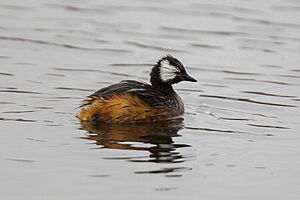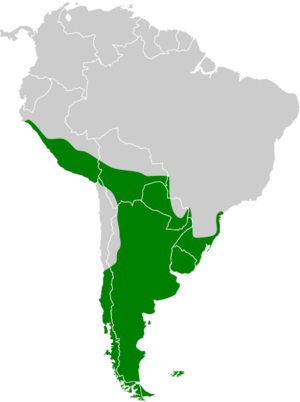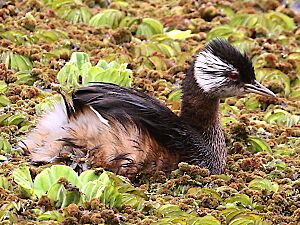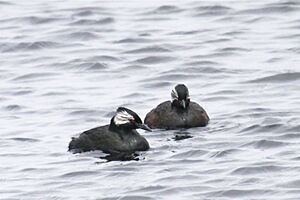White-tufted grebe facts for kids
Quick facts for kids White-tufted grebe |
|
|---|---|
 |
|
| White-tufted grebe in Lima, Peru | |
| Conservation status | |
| Scientific classification | |
| Genus: |
Rollandia
|
| Species: |
rolland
|
 |
|
The white-tufted grebe (Rollandia rolland), also called Rolland's grebe, is a type of grebe. Grebes are diving birds that live on water. You can find this bird in the southern and western parts of South America. It likes to live in freshwater places like lakes, ponds, and slow-moving rivers.
Contents
Types of White-tufted Grebes
There are three main types, or subspecies, of the white-tufted grebe:
- R. r. chilensis – This type lives in southern and western Peru and southeast Brazil, all the way down to Cape Horn and Tierra del Fuego.
- R. r. morrisoni – This type is found only in Lake Junin in the Andean mountains of central Peru.
- R. r. rolland – This type lives in the Falkland Islands.
The biggest difference between these types is their size. The R. r. rolland from the Falkland Islands is much bigger. It can weigh twice as much as the R. r. chilensis type and can barely fly. It also has a deeper reddish-brown color on its belly. The R. r. chilensis and R. r. morrisoni types look very similar, but R. r. chilensis is usually smaller. The Falkland Islands type also acts differently, especially when it's showing off or nesting. Some experts even think it should be its own separate species!
What They Look Like
Both male and female white-tufted grebes look alike. They are about 24 and 36 cm (9.4–14.2 in) long. The birds on the South American mainland are usually smaller, while those in the Falkland Islands are larger.
When it's time to breed, adult grebes have a noticeable black crest, like a small crown, on the back of their heads. They also have a big white fluff of feathers around their ears. The rest of their head, neck, and back are black, sometimes with a greenish shine. Their belly is a dull reddish-brown, often with some brown or grey spots. Their wing feathers are white or pale grey. Their eyes are red, their beaks are black, and their legs are grey or olive-brown.
When they are not breeding, adults are dark brown instead of black. Their crest is much smaller, and the sides of their head and throat become white. Their neck and chest are a light yellowish-brown, fading to white on their belly. Young birds look like adults who are not breeding, but they have brown stripes on their throats and the sides of their necks.
Where They Live and Their Home
The white-tufted grebe lives in the southern and western parts of South America. You can find them from lowlands all the way up to mountains 4,500 m (14,800 ft) high! Their home includes countries like Brazil, Uruguay, Paraguay, Bolivia, Chile, Peru, Argentina, and the Falkland Islands. Sometimes, they even visit the South Sandwich Islands and South Georgia.
They love living in lakes, marshy ponds, ditches, and slow-moving rivers. After the breeding season, the grebes in the southernmost parts of South America gather in groups and fly north along the coast. You might see these groups in calm bays and other protected ocean areas.
Behavior
Reproduction
The way white-tufted grebes reproduce can be different depending on where they live. They have special displays to attract a mate. The most common type, R. r. chilensis, is very protective of its space when breeding. Pairs usually build their nests alone. However, if there aren't many good nesting spots but lots of food, they might nest close to other grebes.
Both R. r. morrisoni from Lake Junin and R. r. rolland from the Falkland Islands always nest alone. The Lake Junin type might even protect its territory all year round. The Falkland Islands type seems less territorial, even during breeding season.
Sometimes, these grebes build their nests near other waterbirds or groups of gulls. Gulls are very aggressive towards animals that might try to eat their eggs or chicks, which can help protect the grebe's nest too!
The white-tufted grebe builds a nest that looks like a floating platform. It's made from reeds, other water plants, or grasses. On the South American mainland, these nests float some distance from the shore, and the birds mate on the nest or another floating plant platform. In the Falkland Islands, the nest also floats but is often tied to the land, or sometimes it's even built on solid ground, under banks by the shore. In the Falklands, mating often happens on solid land, which is quite unusual for a grebe!
This grebe usually lays one to three eggs at a time, but sometimes they can lay up to six. These eggs are typically about 40 by 28 millimetres (1.6 by 1.1 in) in size.
What They Eat
White-tufted grebes mainly eat fish. They also eat arthropods (like insects or spiders) and sometimes water plants. The fish they catch are usually small, but they can be up to about 15 cm (6 in) long. The grebe catches its food by diving into the water. These dives are not very fast and can last up to 20 seconds. Sometimes, they just dip their head underwater while swimming on the surface to find food.
Status
The white-tufted grebe lives in a very large area. The IUCN (International Union for Conservation of Nature) says that this species is of "least concern". This means that even though their numbers might be going down a bit, there are still many of them, so they are not considered threatened.
However, some types of white-tufted grebes are in more trouble. The Junin white-tufted grebe (R. r. morrisoni) has a small population that has dropped a lot. It is considered threatened for similar reasons as the Junin grebe (Podiceps taczanowskii). The Falkland white-tufted grebe (R. r. rolland) also has a small population, estimated to be about 1,000 pairs. This makes it potentially vulnerable, but there's no clear sign that its numbers have gone down recently.




